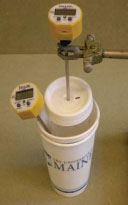 |
NASA | GSFC | JPL | Site Map |
|
|
 |
 |
Education: Student Outcomes |
Click here to search for other assets Heat Flow and Latent Heat Grade level: 5-8 Theme: water cycle Activity: http://www.tos.org/hands-on/teaching_phys_concepts.pdf
When an object gains heat, two things can happen: the temperature of the object can rise, or the object can change its state without a measurable change in temperature (e.g., ice melting into water). Most materials have two state transitions: from solid to liquid and from liquid to gas. The heat needed to change the state of a material is called latent heat of fusion (for changing from solid to liquid) and latent heat of vaporization (for changing from liquid to gas). Latent heats of fusion and vaporization for water are high and have many important consequences for Earth's climate. Videos
Flash Video | QuickTime MovieStudent Outcomes After completing this activity, students should be able to: Explain the energy conversions found in the water cycle (e.g., evaporation requires heat energy, condensation releases heat energy). (W: 5-8) Key: C = climate / O = ocean circulation / T = 21st century technology / W = water cycle |
|||||
